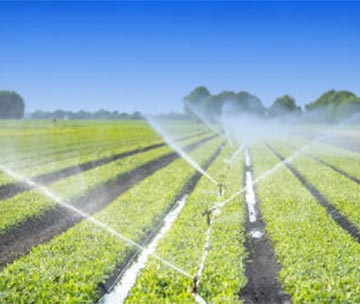
As one of the most under-rated utilities of all time, the modern-day water pump plays a pivotal role in meeting the requirements of your irrigation needs. Selecting the right irrigation pump for agricultural land will not only result in better crop yield but also help save money and power.
Choosing a poor pump, in turn, results in increased power consumption, poor yield, and poor water supply to the crops. So, here are a few pointers to consider before selecting a pump that is worth investing in.
So, now that you have done the first exercise, let us understand the different types of pumps for agriculture and irrigation that are available in the market.

These pumps are usually underwater, completely sealed with heavy motors to draw water from large depths and they are largely used for irrigation. These pumps are defined in stages if the water is to be drawn from the borewells. (Watch the case study of CRI pumps drawing water from over 2000 feet with its 113 stage submersible pumps). Borewell Submersible pumps are thin and tall to fit inside the Borewell. The size of the pumps is measured in mm, depending on the size of your bore.
These pumps are again widely used for agriculture and irrigation, but these pumps are used in open wells. These pumps vary from 1 HP to 10 HP in general and are used to draw water for irrigation. Openwell submersible pumps come in vertical and horizontal format.
These pumps are again widely used for agriculture and irrigation, but these pumps are used in open wells. These pumps vary from 1 HP to 10 HP in general and are used to draw water for irrigation. Open well submersible pumps come in vertical and horizontal format.
If you require pumps to run for a long duration in a day, these pumps are powered by an enclosed fan-cooled motor. Due to this, the heat resistance will be reduced and the water can be pumped for a long duration.
Operated with solar energy, these pumps can operate with the lowest power consumption. For solar pumps, though the initial cost may seem high, most governments offer a significant subsidy to promote green energy.
The location of the water from where it is drawn plays a crucial role in determining the type of pump. For example, turbine pumps and deep-well submersible pumps are ideally used to draw water from underground like wells, borewells, etc. While there are different types of pumps to help draw water from the surface level.
The pump you purchase must fit perfectly with the rest of the irrigation system. All the specifications listed above must match to maximize cost and energy savings. Choose a pump that helps reduce operational cost, by considering the water pressure and the flow. The right pump helps draw water at the right accuracy and at the right time to help yield better crops, better harvest, and thereby leading to better profitability.
Meanwhile selecting the right pump will ensure better water management, thereby making agriculture a sustainable practice.
a. Installation of these pumps is expensive. So if there are any repairs in the pumps, imagine going through the whole process once again, bringing a jack, lifting the pumps outside the waterbody, carrying them to a mechanic shop, repairing the pumps, and shipping back and reinstallation. Not just the physical pain, but during the peak irrigation times, these could cause severe challenges in the irrigation itself, when your plants will dry of no water.
b. The quality of the pumps plays a major role. Here when we say quality, understand where all the pumps may go wrong usually.
Before landing on an irrigation pump, choose a pump company that is reliable and highly reputable. Though the branded pumps are a little expensive compared to the local pumps, you can expect the quality to be much better compared to the local players. Imagine the situation of repairing the pump, which shall cost around 25% of the cost of the pump itself, leaving aside the hardships and mental agony of fixing and the loss of the irrigation season.
A durable pump with a technology up-step along with a service backup, will help your irrigation season and empower your agriculture needs. So think smart and pick a quality product that will last longer and support your growth.
At C.R.I., our engineers and technicians design water pumps for agriculture understanding the hardships of the farmer community. We carefully select the process and deploy a state-of-the-art mechanism to build these pumps with quality at the absolute forefront. C.R.I. offers a wide range of agricultural pumps, and it has been the preferred choice of many farmers over time.
Notifications